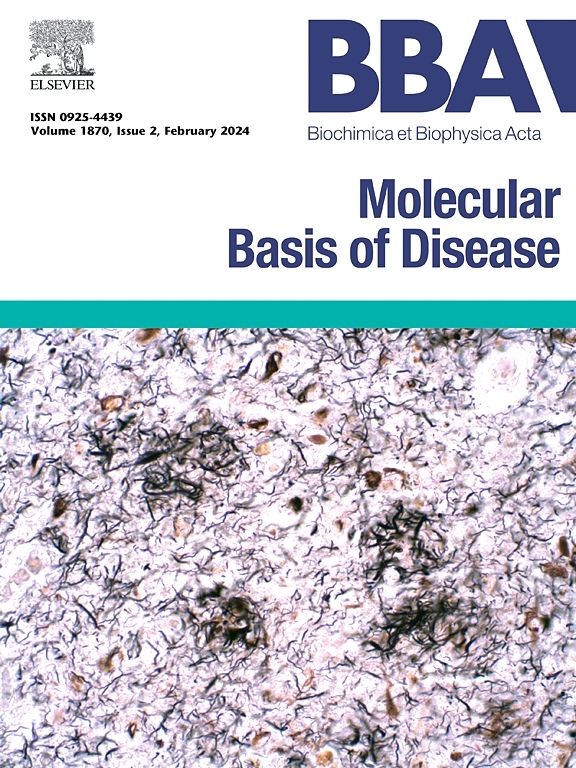Modeling heart failure by induced pluripotent stem cell-derived organoids.
IF 4.2
2区 生物学
Q2 BIOCHEMISTRY & MOLECULAR BIOLOGY
Biochimica et biophysica acta. Molecular basis of disease
Pub Date : 2025-04-18
DOI:10.1016/j.bbadis.2025.167861
引用次数: 0
Abstract
Cardiac organoids offer significant advantages for in vitro studies, as their 3D structure and cellular composition more closely replicate tissue complexity compared to 2D models. This is particularly relevant for studying complex diseases like heart failure (HF), which involve multiple cell types and cardiac structures. Thus, the primary aim of this study was to produce self-assembled, scaffold-free cardiac organoids from induced pluripotent stem cells (iPSCs), capable of simulating key aspects of HF in vitro. Gene expression analysis confirmed a transition from stemness markers (OCT4, NANOG) to cardiac markers (TNNT2, DES), validating their cardiac phenotype. To induce hallmark HF features, endothelin-1 (ET-1) treatment was applied.
Key findings indicate that this experimental model successfully reproduced HF pathological markers, including the upregulation of genes encoding atrial natriuretic peptide (ANP), brain natriuretic peptide (BNP), and the cytoskeletal protein α-skeletal actin (ACTA1), along with changes in microRNA (miR) expression profiles. Functionally, ET-1 treatment reduced organoid contractility, indicating a decline in contractile function—a hallmark of HF. Furthermore, histological analyses by Thioflavin T (ThT) staining, ThT fluorescence assay and filter trap assay on protein extracts demonstrated protein aggregation following ET-1 treatment. Co-administration of various nutraceuticals was shown to mitigate these effects. These findings underscore the value of this ET-1-stimulated cardiac organoid model as a powerful platform for studying HF mechanisms and evaluating novel therapeutic approaches.
通过诱导多能干细胞衍生的类器官模拟心力衰竭。
心脏类器官为体外研究提供了显著的优势,因为与2D模型相比,它们的3D结构和细胞组成更接近地复制了组织的复杂性。这对于研究像心力衰竭(HF)这样的复杂疾病尤其重要,因为它涉及多种细胞类型和心脏结构。因此,本研究的主要目的是从诱导多能干细胞(iPSCs)中产生自组装的、无支架的心脏类器官,能够在体外模拟HF的关键方面。基因表达分析证实了从干性标记(OCT4, NANOG)到心脏标记(TNNT2, DES)的转变,验证了它们的心脏表型。应用内皮素-1 (ET-1)治疗以诱导标志性HF特征。关键结果表明,该实验模型成功复制了HF病理标志物,包括编码心房钠肽(ANP)、脑钠肽(BNP)和细胞骨架蛋白α-骨骼肌动蛋白(ACTA1)的基因上调,以及microRNA (miR)表达谱的变化。在功能上,ET-1治疗降低了类器官的收缩能力,表明收缩功能下降,这是心衰的标志。此外,通过对蛋白质提取物进行ThT染色、ThT荧光试验和过滤陷阱试验的组织学分析表明,ET-1处理后蛋白质聚集。各种营养药品的共同管理被证明可以减轻这些影响。这些发现强调了et -1刺激的心脏类器官模型作为研究HF机制和评估新治疗方法的强大平台的价值。
本文章由计算机程序翻译,如有差异,请以英文原文为准。
求助全文
约1分钟内获得全文
求助全文
来源期刊
CiteScore
12.30
自引率
0.00%
发文量
218
审稿时长
32 days
期刊介绍:
BBA Molecular Basis of Disease addresses the biochemistry and molecular genetics of disease processes and models of human disease. This journal covers aspects of aging, cancer, metabolic-, neurological-, and immunological-based disease. Manuscripts focused on using animal models to elucidate biochemical and mechanistic insight in each of these conditions, are particularly encouraged. Manuscripts should emphasize the underlying mechanisms of disease pathways and provide novel contributions to the understanding and/or treatment of these disorders. Highly descriptive and method development submissions may be declined without full review. The submission of uninvited reviews to BBA - Molecular Basis of Disease is strongly discouraged, and any such uninvited review should be accompanied by a coverletter outlining the compelling reasons why the review should be considered.

 求助内容:
求助内容: 应助结果提醒方式:
应助结果提醒方式:


